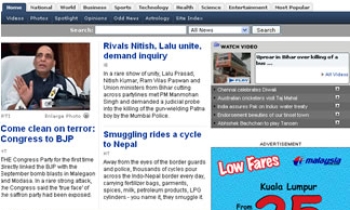"We're in the midst of a long and painful transition," worries Colby Atwood, vice president of the media research company Borrell Associates Inc., commenting on the fact that major American newspapers now have bigger online readerships than their print editions. Katharine Q. Seelye writes in The New York Times that what publishers regret the most about the switch to digital news, apart from its heist of print readers, is that the grand majority of it is free to the reader, a tradition they themselves started at the dawn of the internet news age ten years ago, and one that may now be impossible to change. Rumors that the New York Times has been considering charging for its website have caused a stir, those in favor arguing that quality content deserves respect with paid access by readers, those against arguing that the internet has transformed access to information into a kind of born right. Here are three points in support of the latter:
- Attracting and sustaining readership: Free online news, now more popular than print in most cases, is not only an alternative source for regular readers fed up with paying rising subscription prices and hauling piles of papers to the recycling bin, but is also a great way to maintain and increase clientele in the future through exploiting the habits of younger generations. Let's face it, younger readers are so accustomed to and adept at using the internet and so enjoy its interactivity, that they just really don't need print anymore, and unless we find the Fountain of Youth in the next few years, habitual newspaper readers will soon be gone. Between the success of free papers and the internet, which youth expect to be free, the newspaper readers of the future simply won't accept a pay model.
- Advertising: Internet advertising is booming. Some studies show a 40% jump from last year. Although it still only accounts for roughly two to three percent of newspaper revenue, it is publishing companies' fastest growing revenue source and will continue to grow, as long as newspapers keep their websites free. Online ads not only provide advertisers with more innovative ways to push their wares than static print pages, but most importantly provide immediate demographic feedback something that can't be equaled in other medium. Charging for websites can handicap advertising revenue, as proven in the case of the Wall Street Journal, the only major American newspaper to charge subscription fees for its online content. The Journal recently bought the free financial site MarketWatch, primarily to give its advertisers more online visibility.
- It's simply too late: The outlook for paid daily news is not good, especially now in the nascent stages of citizens journalism and the increasing push for free archives. Newspapers make a good point in saying that their quality product should be paid for, but there are so many alternative free sources of news that switching to a paid online business model could be financially devastating for newspapers, as readers will certainly start reading their news on Google or Yahoo. Take the example that Ms. Seelye uses of a 100,000 circulation Washington state newspaper whose switch to paid content not only abruptly halted a steady 40% yearly rise in traffic, but actually caused online readership to drop by 5% in a year. Of course, ten years ago, at the dawn of the internet news era, newspapers effectively signed their own pay-model death wish by putting the same content that was in their print editions online for free.
But on a positive note, this brave idea has greatly facilitated the evolution of the internet, the "free"dom of information, and has in fact made newspapers more visible. Chances are, if papers had begun charging for online content back in the day, declines in print sales would have continued and millions of people, especially youth, who were beginning to spend more time online would not have begun to read their papers. The challenge that newspapers now face is not how to increase revenues directly from the pockets of their online readers, but how to take advantage of the opportunities offered by the internet in order to attract more readers to their digital news pages adorned with demographically specified advertising.









